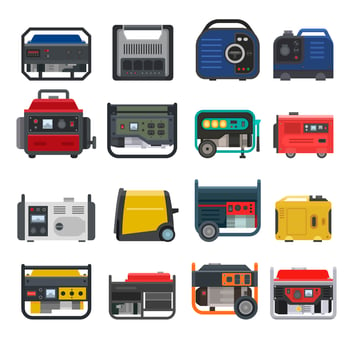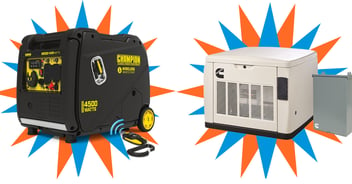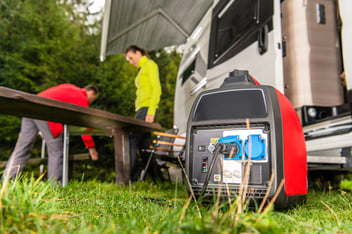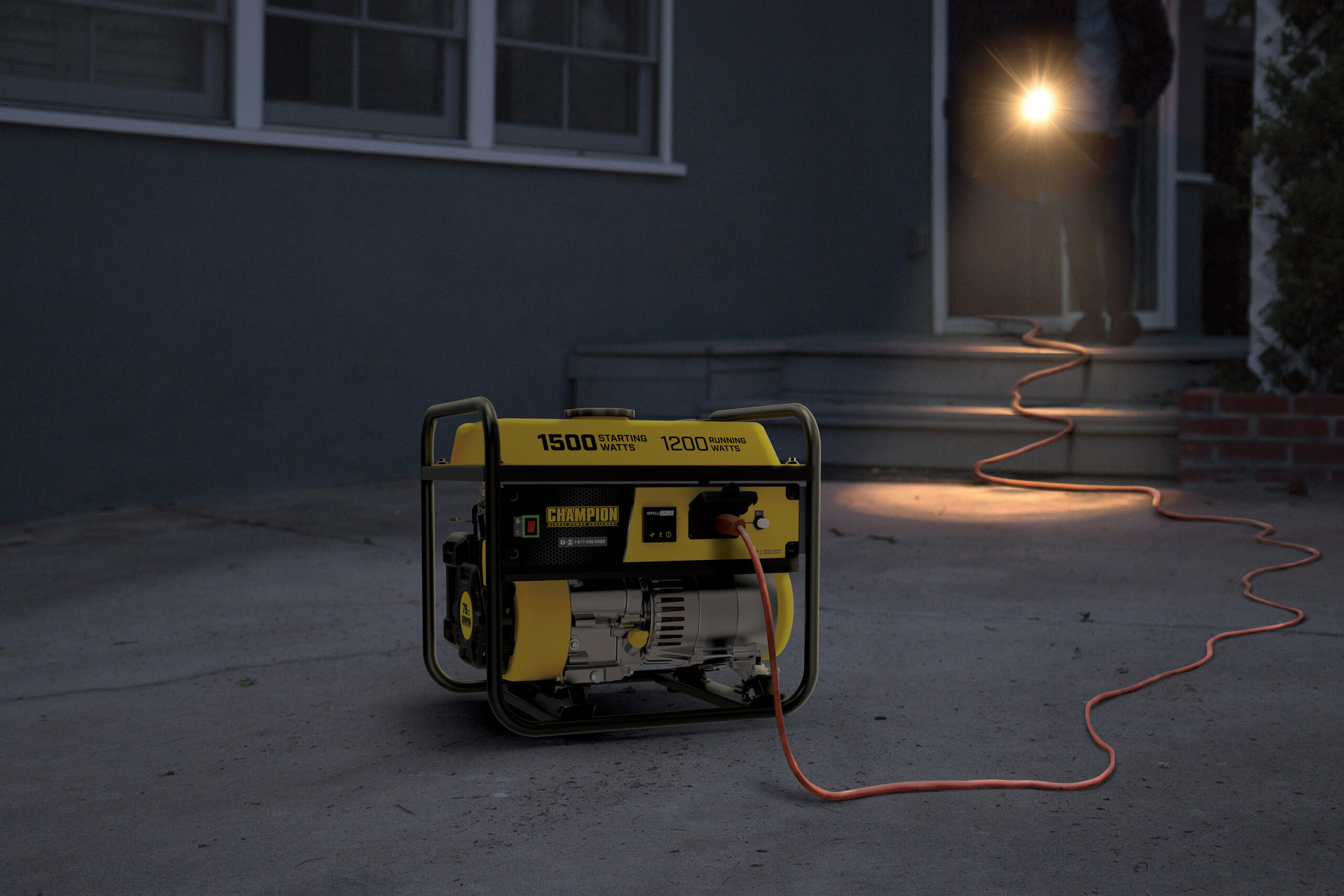Portable gasoline generators are wonderful because for a reasonable cost, the provide consumers with a electricity under most conditions. While portable generators (especially inverter generators), such as the Cummins P4500i or MultiQuip 3.6 kW, are designed for RV camping, tailgating or use on a construction job site, they can also be used to power your home during a power outage.
What are portable generators?
Portable generators are small, easily transportable generators that are powered by either gasoline (petrol) or diesel. They differ from home standby generators in that they have an on-board fuel tank and can be moved by 1-2 people or a vehicle quite easily. They range from 2 kW to 9.5 kW in electrical capacity.
Reputable manufacturers of portable consumer generators include Cummins Onan, Multiquip, Champion, Briggs & Stratton, Kubota, and Generac. Portable generators come in two general styles:
- Inverter Generators – Inverter generators are popular because they produce very clean power (low distortion) and are able to vary their engine speed (RPMs) with the electrical load. This allows them to conserve fuel and produce less noise under low loads. Inverter generators often have noise insulation to further decrease the sound of operation. They are generally more expensive per kW than standard generators for the above features and are very common in the RV camping crowd.
- Standard Generators – more standard portable generators, often referred to as job site generators or storm generators, are open frame generators that run at a constant speed. They are normally a bit louder than camping generators but produce more power.
How to prepare for a grid outage?
Taking the below steps prior to an outage is essential to having the necessary equipment ready to provide emergency power for your home and family.
1) Purchase your generator before the storm / outage – delaying the purchase of a generator until an actual outage will put you in competition with every other person seeking a solution to the outage. By buying ahead of time, you can secure your family’s ability to have power. Additionally, shipment into storm, hurricane or disaster areas can be unreliable, meaning your generator may get delayed when purchased immediately after an outage.
2) Secure the necessary accessories – Purchasing the generator is the starting point to preparedness, but getting the right accessories will enable the use of the generator for your home. The first items to procure are operational (fuel can, extension cords, high altitude kit – if needed) while others are nice to have (generator cover). Thinking through extension cords is important as you will need to run the generator outdoors and away from the house but still need to move the electricity to appliances. The use of travel trailer (TT) cords with a Reliant transfer switch can be a highly effective strategy (more below).
3) Establish a supply of fuel for your generator – During an outage, fuel supplies can become scarce, so it’s best to buy gasoline, propane, or diesel before the storm. Place the fuel in approved containers in a secure location away from your home and out of the sun. Use your generator’s fuel consumption chart to determine the amount of fuel you will need to cover the anticipated blackout. Starting with 24-48 hours of run time is a good bench march (especially if you don’t run the generator 24/7).
4) Maintain your generator
You should start your generator to ensure proper function at the beginning of storm season (spring for the hurricane zone, fall for northern states). If you ran the generator >50 hours or it’s been more than 6 months, you should perform interval maintenance. This generally includes changing the oil and cleaning the air filter but refer to your generator maintenance manual for specifics. If you have serious issues with the generator, seek assistance from your local dealer or a small engine repair shop.
5) Prepare a location to run the generator
Homeowners should identify a location that they can run their generator from. This spot should be accessible for running extension cords and TT-cables from as well as for refueling the generator, but should be away from windows and small children. The generator should be placed away from the house, with the exhaust facing away from the home or other obstructions. Most generators are not designed to run in the rain, so planning for a covered outdoor location may take some creativity or minor construction. Generator Tent makes an exterior cover that sits above the generator and protects it from most weather while running.
Methodologies for connecting portable generator to your home
Once the generator is capable of operating, the next step to powering your home during an outage is deciding how to move the electricity from the generator to appliances. One important note is that during an outage, appliances must be disconnected from the grid to prevent back feeding power. There are two main methods for connecting the generator:
- Directly connect generator to appliances – This is the simplest method for connecting the generator to appliances, involving running extension cords between the two. The only equipment needed is sufficient lengths of cords to run from the outdoor generator into the home where the appliance is located. These cords create a potential tripping hazard but can be accomplished with standard extension cords that are purchased as a home improvement store.
- Utilize transfer switch to distribute electricity – Installing a transfer switch will allow the homeowner to move electricity from the generator through the home’s existing wiring to the appliances. The advantage to this setup is that a single TT-style cable connects the generator to the house and then power is distributed from there to appliances, eliminating the need for potentially dangerous extension cords. Prior to the storm, the homeowner should invest in a manual transfer switch, such as the Reliance 310CDKN, to serve as the grid disconnect and distribution panel. It is advisable to have a certified electrician wire this panel into the circuits to be powered by the generator.
Using either methodology, it is important to note that your portable generator likely will not be able to run every appliance in your home simultaneously. Appliances that have an electric motor, such as your air conditioning unit, require a significant in-rush current to start. This in-rush can be 3-4 times the power required to operate the appliance once started.
Homeowners can strategically plan to start appliances sequentially to avoid overloading the generator. This might look like starting the air conditioning system and once running, start the refrigerator, and finally turning on interior lights.
RELATED POSTS
Proin auctor nibh vitae urna lobortis, in vulputate erat facilisis. Sed lacinia lorem eget orci finibus, et maximus nisi sagittis.

Consumer Generator Basics – Home Standby & Portable Generators
The two questions of “what kind of generator do I need” and “how big of a generator do I need” are the most common areas of concern for people...
Read more »
Standby And Portable Generators For Emergency Power
Wherever you may live in the world, a power outage is always a possibility and a concern. During an extended power outage, your home or business...
Read more »
How to Select the Best Portable Generator for Your RV
RV and camping season is just around the corner. Outdoor adventure’s with friends and family brings a need to have reliable power in the form of a...
Read more »
